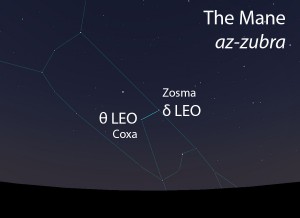Star Names
The Mane (az-zubra)
The Two Ribs (al-kharatan)
The Mane is part of the Arabian megaconstellation of the Lion (al-asad). In the context of the other elements of the Lion, the two stars of the Mane mark the rear edge of the mane. This pair was also called the Two Ribs (al-kharatan), alternatively translated as the Two Piercings, the places along the side of a lion’s body where it would be speared.
Appearance
A pair of bright stars that follows right after the Forehead (al-jabha).
Modern Identification
δ LEO (Zosma), blue-white star, magnitude 2.6
θ LEO (Coxa), blue-white star, magnitude 3.3
Timing
Ibn Qutayba (d. 879 CE) reported that the Mane was said to rise on the morning of August 28 and set on the morning of February 26. On account of the precession of the equinoxes, today we can expect to observe the Mane setting in early April and rising in mid-September, as seen from the latitude of Tucson. (See How to Observe on the About page for more on this topic.)
Rain Stars
The Mane does not figure in the calendar of the rains stars.
Lunar Stations
In early listings of the lunar stations, the Mane is the 13th station of the year. This was later changed to the 11th lunar station after the stations were adjusted to begin with the vernal equinox. The stars of the Mane match the Hindu nakshatra called Purva Phalguni.
Related Stars and Celestial Complexes
The Mane is part of the Lion (al-asad, الأسد) folkloric celestial complex, which extends from the Two Forearms (adh-dhira’an, الذراعان) to the Two Shanks (as-saqan, الساقان).
Related Blog Posts


